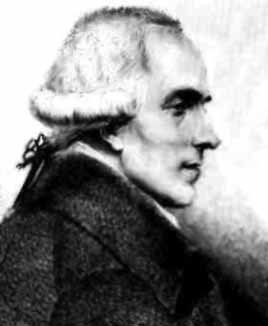
| The simplest of these whole lot of problems is the 1-body problem, which solution is known to all Physics students. The 2-body problem was solved by Isaac Newton (1642-1727) in his famous Principia, expressed in the form of Newton's Law of Gravitation. The 3-body problem proved to be difficult for even Newton could not solve it. Mathematicians working on the problem soon realized they had to simplify the problem by looking at special cases like: one particle is much less massive than the other two, or 2 particles are much less massive than the third, etc. Pierre-Simon de Laplace (1749-1827), a strong advocate of the deterministic universe, managed to solve a special case, but failed at the general one. |  |
 |
It soon became clear that a different approach has to be adopted. The
standard technique used (even today) is Perturbation Theory: you start off
with a 2-body solution, then add the contribution of the third body,
assuming it is small. Under this condition, the solution is expressible as
a series. In 1885, Karl Weierstrass (1815-1897), Charles
Hermite(1822-1901) and G�sta Mittag-Leffler (1846-1927), came
up with 4 outstanding problems in what is now called the Oscar II Contest.
Anyone solving any of these would be awarded 2500 gold crowns and a medal
in 1889 on the 60th birthday of the Swedish King. One of these
is the n-body problem. Weiestrass framed the problem in a particular way,
because he believed there is no closed-form solution to this problem (this
was confirmed later). He proposed to the participants to find a single
convergent series as the required solution.
In 1889, Henri Poincar� (1854-1912), the 'last universalist of Mathematics' (someone well-versed in all fields of Mathematics), tried his hands at the problem, but failed in his attempt too. However, his 270-page work laid the foundation of Chaos Theory and because this work was so revolutionary, he was awarded the prize. He published his work in the journal Acta Mathematica. |
For the 3-body problem, 9 integrals were needed for a complete solution. In 1892, Heinrich Bruns (1848-1919) showed that not all of them can be expressed in a closed form and that small perturbations can cause the series to change from convergent to divergent. In 1913, Karl Sundman (1873-1949) of Finland accomplished what the Oscar II Contest asked for. He got a convergent series for the 3-body problem but the convergence was so slow that it is really useless. In the 1960s, Stephen Smale (1930-)of the US showed that dynamical systems (e.g. the 3-body problem) can be understood in terms of topological transformations. Advances in Perturbation Theory is made by Richard Feynman (1918-1988), who introduced his Feynman Diagrams to simplify the working. In 1991, Wang Qiu Dong also obtained a convergent series for the 3-body problem. In his solution, he resolved the problem of collisions. Suppose the bodies do collide, then their trajectories could be affected and this prevents the series from converging. What Wang did was to introduce a measure of time that ran faster as two or more bodies approach each other, so that the collision would occur only at infinite time. However, again the convergence is too slow to be useful.
Short notes on some of the mathematicians mentioned in this page.
1. Laplace (French) is a mathematical genius. He contributed to
Integral Calculus, Differential Equations, Difference Equations. He treated
Probability more mathematically then others before him and he applied
Mathematics to many fields of Physics, particularly Astronomy.
2.
Weierstrass (German) is called the "Father of Modern Analysis"; he
contributed to Calculus of Variation, Elliptic Functions, Periodic Functions,
Series Convergence Test and other topics in Modern Analysis. Among his most
famous works are the discovery of continuous function that is non-differentiable
at every point, and proving that the Complex Numbers are the only commutative
algebraic extension of the Reals.
3. Hermite (French) is famous for
his proof of the transcendentality of e, the base of Natural Logarithm,
in 1873.
4. Mittag-Leffler (Swedish) founded the journal Acta
Mathematica in 1882.
5. Smale (American) made great contribution
to Poincar� Conjecture, Morse Theory, Dynamic Systems and Computational Theory.
6. Feynman (American) contributed mainly to Quantum Mechanics and
Particle Physics.
Return to Maths Homepage